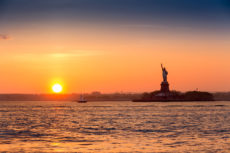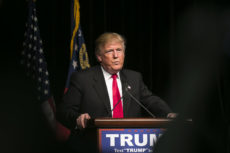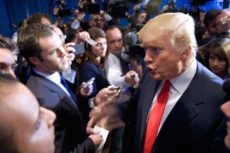Samuel R. Staley • Thursday, November 10, 2016 •
 With faith comes conviction; with conviction comes courage; with courage comes action; with action comes leadership; with leadership comes social change. That chain could easily encapsulate the main storyline of Hacksaw Ridge, an engaging and sobering biopic focused on the heroic acts of World War II medic Desmond Doss.
With faith comes conviction; with conviction comes courage; with courage comes action; with action comes leadership; with leadership comes social change. That chain could easily encapsulate the main storyline of Hacksaw Ridge, an engaging and sobering biopic focused on the heroic acts of World War II medic Desmond Doss.
Desmond Doss was a Seventh Day Adventist when he enlisted in the Army to fight during World War II. His faith had deep personal roots, a reaction to his violent childhood where he was physically encouraged to fight with his brother and was abused by his alcoholic father. His pacifism arose in the aftermath of a fight where he nearly killed his brother as a child (at least in the film version of the story). He interpreted the commandment “thou shalt not kill” as literal and universal (he was also a vegetarian). Allegiance to this commandment wouldn’t normally be a problem, unless you enroll in the Army during wartime. Doss felt the call to serve his country after the Japanese attacked Pearl Harbor, and he reasoned he could serve his country by saving the lives of men as a medic. So, he joined as a Conscientious Objector, and became one of the few enlistees to be granted CO status.
The story, however, is as much about Doss’s comrades as it is about his own life. Doss (played artfully in an understated performance by Andrew Garfield of The Social Network and Spider-Man fame) remains steadfast in his faith and pacifism even as he is faced with physical abuse by his fellow recruits in basic training, relentless pressure by his commanding officers (played by Vince Vaughn and Sam Worthington) to quit, a court martial that nearly landed him in jail for the remainder of the war, and a relentless deluge of bullets, mortar shells, and artillery barrages in one of the bloodiest battles of the war (Okinawa). His fellow soldiers are resentful of his unwillingness to even train with a rifle, believing his beliefs are simply cover for cowardice. This resentment continues as they enter battle, but are won over by Doss’s unflinching courage and dedication to saving them as their company is decimated and eventually overrun by the Japanese.
Doss saved at least 75 U.S. soldiers in real life, and the movie does a great job of giving the audience a close up of many of them as Doss carries them on his back in the midst of battle, hides them from roving Japanese patrols, and lowers them down a 400 foot cliff to safety on the beach. He stayed on the ridge to save his comrades, despite their abuse and doubts, even after his company had abandoned their positions. His bravery and commitment to each of them, regardless of how badly they treated him, changed their hearts and their understanding of courage. Doss was the first Conscientious Objector to earn the U.S. military’s highest honor—the Medal of Honor—and viewers will have no doubt why at the end of the immersive film.
Hacksaw Ridge takes a few liberties—Doss actually served in three major battles in the Pacific in addition to Okinawa (Guam and Leyte), and his heroic acts unfolded over weeks rather than days, among others more minor—but the film stays largely true to the real-life story. The battle scenes have been likened to Saving Private Ryan in their realism, earning a R rating and an element that shouldn’t surprise audiences that have seen director Mel Gibson other movies such as Braveheart or The Passion of the Christ. He doesn’t spare his audiences from the brutal horror of war, and that serves the purpose of the story while honoring the faith-driven courage of Doss. Indeed, the graphic nature of the scenes, death, and injuries on both sides of the battle are essential to conveying the depth of his faith. Physically exhausted and emotionally drained, Doss keeps his faith, imploring God to give him the strength “save one more.” These aren’t mere words in dialogue; they were words he uttered to himself at the moment as a video interview of the real-life Doss shows at the end of the film.
The cinematography is awe inspiring, from the vistas of the land beach to the devastated ground strewn with corpses, maimed humans, and burnt foliage even though the film is a bit plodding in the first 30 minutes as Doss’s backstory is fleshed out. The pace quickens, however, once Doss enters boot camp, and he faces the hostility of other recruits. Gibson uses several pivotal plot points, including a moment when his fiancée encourages him to quit to avoid being imprisoned for disobeying an officer, to bring the audience along as Doss’s each test solidifies his convictions and emboldens him to continue. One of the more memorable moments in the film is near the end the battle, when Doss picks up the rifle of a wounded soldier as the Japanese advance on their position. The soldier—his drill instructor (Vaughn) from boot camp—smiles wryly thinking that Doss is finally going to give in and take up the rifle to defend himself and their position. Instead, he uses the rifle to fashion a stretcher to pull his abusive sergeant to safety (as the sergeant shoots at the enemy during their retreat).
Libertarians and conservatives put a lot of thought, time, and effort into the importance of building the voluntary institutions necessary to maintain a civil society. Too little attention, in my view, is put into the importance of faith in providing the courage to challenge and overcome those political and social forces that undermine and destroy it. Hacksaw Ridge uses the faith and courage of Desmond Doss to show just how important those elements of character are, and how their sincere and steadfast application change hearts and minds. Although Hacksaw Ridge can be viewed as an anti-war film, the story is more than testimony to the brutality of war and the nobility of pacifism; it’s an extended, unflinching reflection on the nexus between faith, courage, and leadership in a place where the descriptor “hell” understates the true magnitude of the horror people face and how souls are tested.
 The best measurement of people who lack health insurance, the National Health Interview Survey published by the Centers for Disease Control and Prevention (CDC), has released early estimates of health insurance for all fifty states and the District of Columbia in the first half of 2016. There are three things to note.
The best measurement of people who lack health insurance, the National Health Interview Survey published by the Centers for Disease Control and Prevention (CDC), has released early estimates of health insurance for all fifty states and the District of Columbia in the first half of 2016. There are three things to note. Like many Americans, I was surprised with the results of our recent presidential election. I had assumed, like so many others, that a Clinton presidency was inevitable.
Like many Americans, I was surprised with the results of our recent presidential election. I had assumed, like so many others, that a Clinton presidency was inevitable. We’ve heard the complaints about how money influences politics, but the recent presidential election shows that money doesn’t always Trump voter preferences.
We’ve heard the complaints about how money influences politics, but the recent presidential election shows that money doesn’t always Trump voter preferences. Both Donald Trump and Hillary Clinton called for innovative solutions for what ails America. For the former it was a new fence on our southern border that will supposedly be funded by Mexico; for the latter it was free (i.e., taxpayer subsidized) college tuition. Fresh ideas, they told us, could “make America great again” and render us “stronger together.”
Both Donald Trump and Hillary Clinton called for innovative solutions for what ails America. For the former it was a new fence on our southern border that will supposedly be funded by Mexico; for the latter it was free (i.e., taxpayer subsidized) college tuition. Fresh ideas, they told us, could “make America great again” and render us “stronger together.” I’m not sure what to think about the
I’m not sure what to think about the  With faith comes conviction; with conviction comes courage; with courage comes action; with action comes leadership; with leadership comes social change. That chain could easily encapsulate the main storyline of
With faith comes conviction; with conviction comes courage; with courage comes action; with action comes leadership; with leadership comes social change. That chain could easily encapsulate the main storyline of  The Office of Management and Budget (OMB) has designated 16 programs as “high error,” meaning that money goes offside due to fraud, waste, and abuse. Medicaid, the joint state-federal program that subsidizes medical services for low-income people, ranks highly on the list. The U.S. government considers almost ten percent of its $297.7 billion contribution to Medicaid—$29.1 billion—to be paid “
The Office of Management and Budget (OMB) has designated 16 programs as “high error,” meaning that money goes offside due to fraud, waste, and abuse. Medicaid, the joint state-federal program that subsidizes medical services for low-income people, ranks highly on the list. The U.S. government considers almost ten percent of its $297.7 billion contribution to Medicaid—$29.1 billion—to be paid “ As the markets and pundits react to Donald Trump’s enormous upset victory, let me offer my own reactions. As an economist, I will focus on matters pertaining to economic policy.
As the markets and pundits react to Donald Trump’s enormous upset victory, let me offer my own reactions. As an economist, I will focus on matters pertaining to economic policy.
 Criticizing the U.S. Armed Forces is largely taboo. For many, U.S. military programs are a sacred cows, something to be shielded from criticism and any sort of objection. Even those who are usually critical of other forms of government spending and growth balk at the idea of cutting military spending or reducing the U.S. military’s bootprint.
Criticizing the U.S. Armed Forces is largely taboo. For many, U.S. military programs are a sacred cows, something to be shielded from criticism and any sort of objection. Even those who are usually critical of other forms of government spending and growth balk at the idea of cutting military spending or reducing the U.S. military’s bootprint.




